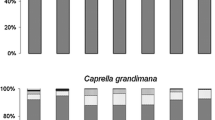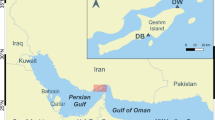Abstract
The natural diet of Plagusia dentipes de Haan was studied in Tateyama Bay, Japan, between June 2004 and May 2005. A total of 389 specimens were collected for analysis of stomach content during the period, with sizes ranging between 7.1 and 63.1 mm in carapace width. The major dietary item was rhodophycean algae (mostly articulated coralline algae), which was ingested by 91.8% of the crabs and accounted on average for 55.6% (points) of the volume of stomach contents. Chlorophycean algae (mostly Ulvaceae, 39.1% and 8.1 points) and crustaceans (mostly amphipods, 38% and 3 points) came next in feeding frequency and volume. Minor dietary items also included other algae such as Phaeophyceae and animals such as mollusks (bivalves, gastropods), annelids (polychaetes), other crustaceans (caprellids, isopods), and echinoids. Significant seasonal dietary differences were observed and, in general, the diet in spring contained more food items, particularly more animals, compared to other seasons. Feeding of Rhodophyceae was highest and lowest in winter and summer, respectively. The total volume of food consumed was also lowest in summer and likely reflected reduced availability of the main food item in this season. There were no differences in dietary items between male and female crabs. In conclusion. P. dentipes is a primarily herbivorous crab with incidental or opportunistic feeding on animal items, and it is suggested that seasonal shifts in consumption may be related to growth, molting, and reproductive activity.
Similar content being viewed by others
References
Schubart CD, Ng PKL. On the identities of the rafting crabs Cancer depressus Fabricius, 1775, Cancer squamosus Herbst, 1790, Plagusia immaculata Lamarck, 1818 and Plagusia tuberculata Lamarck, 1818 (Crustacea: Decapoda: Brachyura: Plagusiidae). Raffles Bull. Zool. 2000; 48: 327–336.
Schubart CD, Gordillo JIG, Reyns NB, Liu HC, Cuesta JA. Are Atlantic and Indo Pacific populations of the rafting crab, Plagusia depressa (Fabricius), distinct? New evidence from larval morphology and mtDNA. Raffles Bull. Zool. 2001; 49: 301–310.
Dawson EW. A key to the world species of Plagusia (Crustacea: Brachyura), with a new record of P. depressa tuberculata Lamarck from New Zealand. Natl. Mus. N. Z. Rec. 1987; 3: 37–45.
Carlton JT. Patterns of transoceanic marine biological invasion in the Pacific Ocean. Bull. Mar. Sci. 1987; 41: 452–465.
Dai A, Yang S. Crabs of the China Seas. China Ocean Press, Beijing. 1991.
Bennech SV. Ocean transport of a community of the grapsid crab Plagusia dentipes (de Haan, 1833). Crustaceana 1978; 35: 104.
Sakai T. Crabs of Japan and the Adjacent Seas. Kodanshya, Tokyo, Japan. 1976.
Aikawa H. Further notes on brachyuran larvae. Rec. Oceanogr. Work. Jpn. 1937; 9: 87–162.
Muraoka K. On the secondary sexual characters of the post larval stages of a shore crab, Plagusia dentipes de Haan. Res. Crust 1963; 1: 54–65.
Terada M. Zoeal forms of 14 species of crabs from the Enshunada. Res. Crust 1987; 16: 92–119.
Gordillo JIG, Tsuchida S, Schubart CD. Redescription of the megalopa of Plagusia dentipes (Brachyura: Plagusiidae) from Japan. Crust. Res. 2000; 29: 143–151.
Watanabe S, Tsuchida S, Nakamura N. The daily settlement of the grapsid crab Plagusia dentipes de Haan (Brachyura: Grapsidae) in relation to environmental factors. Res. Crust 1992; 21: 153–158.
Tsuchida S, Watanabe S. Growth and reproduction of the grapsid crab Plagusia dentipes (Decapoda: Brachyura). J. Crust. Biol. 1997; 17: 90–97.
Buck TL, Breed BA, Penning SC, Chase ME, Zimmer M, Carefoot TH. Diet choice in an omnivorous salt-marsh crab: different food types, body size, and habitat complexity. J. Exp. Mar. Biol. Ecol. 2003; 292: 103–116.
Cannicci S, Gomei M, Boddi B, Vannini M. Feeding habits and natural diet of the intertidal crab Pachygrapsus marmoratus: opportunistic browser or selective feeder. Estuar. Coast. Shelf Sci. 2002; 54: 983–1001.
Brousseau DJ, Baglivo JA. Laboratory investigations of food selection by the Asian shore crab, Hemigrapsus sanguineus: algal versus animal preference. J. Crust. Biol. 2005; 25: 130–134.
Jin G, Xie P, Li Z. Food habits of two year old Chinese mitten crab (Eriocheir sinensis) stocked in Lake Bao’an, China. J. Freshwater Ecol. 2003; 18: 369–375.
Kyomo J. Variation in the feeding habits of males and females of the crab Sesarma intermedia. Mar. Ecol. Prog. Ser. 1992; 83: 151–155.
Guebas FD, Verniert M, Tack JF, Koedam M. Food preference of Neosarmatium meinerti de Man (Decapoda: Sesarminae) and its possible effect on the regeneration of mangroves. Hydrobiologia 1997; 347: 83–89.
Kennish R, Williams GA, Lee SY. Algal seasonality on an exposed rocky shore in Hong Kong and the dietary implications for the herbivorous crab Grapsus albolineatus. Mar. Biol. 1996; 125: 55–64.
Birch DW. Food preferences of Hemigrapsus nudus (Dana, 1851) (Decapoda, Grapsidae) on San Juan Island, Washington, U.S.A., Crustaceana 1979; 36: 186–188.
Erikson AA, Saltis M, Bell SS, Dawes CJ. Herbivore feeding preferences as measured by leaf damage and stomatal ingestion: a mangrove crab example. J. Exp. Mar. Biol. Ecol. 2003; 289: 123–138.
Puccio V, Relini M, Azzuro E, Relini LO. Feeding habits of Percnon gibbesi (H. Minlne Edwards, 1853) in the Sicily Strait. Hydrobiologia 2006; 557: 79–84.
Guebas FD, Giuggioli M, Oluoch A, Vannini M, Cannici S. Feeding habits of non ocypodid crabs from two mangrove forests in Kenya. Bull. Mar. Sci. 1999; 64: 291–297.
Iribarne O, Bortolus A, Botto F. Between habitat differences in burrow characteristics and trophic modes in the south-western Atlantic burrowing crab Chasmagnathus granulata. Mar. Ecol. Prog. Ser. 1997; 155: 137–145.
Chen RB, Watanabe S, Yokota M. Feeding habits of an exotic species, the Mediterranean green crab Carcinus aestuarii, in Tokyo Bay. Fish. Sci. 2004; 70: 430–435.
William MJ. Methods for analysis of natural diet in portunid crabs (Crustacea: Decapoda: Portunidae). J. Exp. Mar. Biol. Ecol. 1981; 52: 103–113.
Wear RG, Haddon M. Natural diet of the crab Ovalipes catharus (Crustacea, Portunidae) around central and northern New Zealand. Mar. Ecol. Prog. Ser. 1987; 35: 39–49.
Sokal RR, Rohlf FJ Introduction to Biostatistics W.H. Freeman, San Francisco. 1973.
Hays WL. Statistics, 5th edn. Wadsworth Publishing, New York. 1994.
Bernárdez C, Freire J, González-Gurriarán E. Feeding of the spider crab Maja squinado in rocky subtidal areas of the Riá de Arousa (north-west Spain). J. Mar. Biol. Assoc. U.K. 2000; 80: 95–102.
Knudsen JW. Shell formation and growth of the California xanthid crab. Ecology 1959; 40: 113–115.
Nicotri ME. Factors involved in herbivore food preference. J. Exp. Mar. Biol. Ecol. 1980; 42: 13–26.
Paine RT, Vadas RL. Calorific values of marine benthic algae and their postulated relation to invertebrate food preference. Mar. Biol. 1969; 90: 103–109.
Akioka H, Baba M, Masaki T, Johansen HW. Rocky shore turfs dominated by Corallina (Corallinales, Rhodophyta) in northern Japan. Phycol. Res. 1999; 47: 199–206.
Mantelatto FLM, Christofoletti RA. Natural feeding of the crab Callinectes ornatus (Portunidae) in Ubatuba Bay (São Paulo, Brazil): influence of season, sex, size and molt stage. Mar. Biol. 2001; 138: 585–594.
Haefner PA jr. Natural diet of Callinectes ornatus (Brachyura: Portunidae) in Bermuda. J. Crust. Biol. 1990; 10: 236–246.
Freire J. Feeding ecology of Liocarcinus depurator (Decapoda: Portunidae) in the Riá de Arousa (Galicia, north-west Spain): effect of habitat, season and life history. Mar. Biol. 1996; 126: 297–311.
Woods CMC. Natural diet of the Notomithrax ursus (Brachyura: Majidae) at Oaro, South Island, New Zealand. N. Z. J. Mar. Freshw. Res. 1993; 27: 309–315.
Laughlin RA. Feeding habits of the blue crab, Callinectes sapidus Rathbun, in the Aphalachicola Estuary, Florida. Bull. Mar. Sci. 1982; 32: 807–822.
Kennish R. Seasonal pattern of food availability: influences on the reproductive output and body condition of the herbivorous crab Grapsus albolineatus. Oecologia 1997; 109: 209–218.
Author information
Authors and Affiliations
Corresponding author
Rights and permissions
About this article
Cite this article
Samson, S.A., Yokota, M., Strüssmann, C.A. et al. Natural diet of grapsoid crab Plagusia dentipes de Haan (Decapoda: Brachyura: Plagusiidae) in Tateyama Bay, Japan. Fish Sci 73, 171–177 (2007). https://doi.org/10.1111/j.1444-2906.2007.01315.x
Received:
Accepted:
Issue Date:
DOI: https://doi.org/10.1111/j.1444-2906.2007.01315.x




